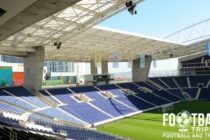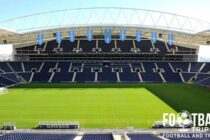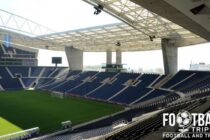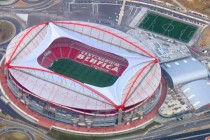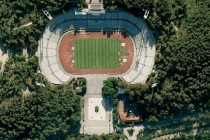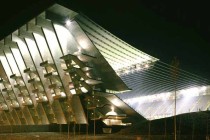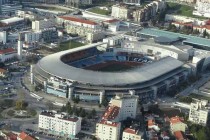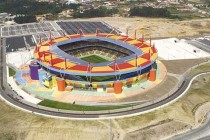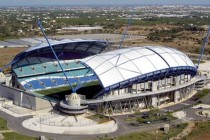Estádio do Dragão translated in English as Stadium of the Dragon, is the purpose built football stadium belonging to Portuguese powerhouse F.C Porto. Inaugurated in 2003 with a friendly match against FC Barcelona, the 50,431 capacity ground hosted the opening ceremony of UEFA Euro 2004 as well as five matches at various stages of the tournament.
Porto Stadium Guide
Stadium Facts
| Overview | |
|---|---|
| Team: | Porto |
| Opened: | 2003 |
| Capacity: | 50,035 |
| Address: | Via Futebol Clube do Porto, Porto, 4350-415 |
| Pitch Size: | 115 x 68 m |
| Record Attendance: | 52,000 vs Barcelona (16th November 2003) |
| Stadium Owner: | FC Portoq |
| Operator: | Porto Estádio |
| Wikipedia: | https://en.wikipedia.org/wiki/Est%C3%A1dio_do_Drag%C3%A3o |
| Stadium Names | |
| Names: | Dragon Stadium (English), Estádio do Dragão (Portuguese) |
| Construction Details | |
| Broke Ground: | 2000 |
| Built: | 2000-2003 |
| Architect: | Manuel Salgado |
| Construction Cost: | €125 million |
| Structural Engineer: | Somague |
Estadio do Dragao History
Estádio do Dragão is the name of FC Porto’s home ground which was built to host matches of the Euro 2004 tournament, replacing the club’s former 1952 built home, Estádio das Antas. Known as the Stadium of the Dragon in English after the club’s nickname of Dragões which stems from the mythical creature appearing on the club’s badge, the inaugural match was held against Barcelona on the 16th November 2003.
This fixture attracted a record crowd of 52,000 although the official capacity currently sits at 50,431. During the Portuguese hosted Euros, Estádio do Dragão hosted five matches including the curtain raising match between hosts and eventual winners Greece. Portugal lost the opening fixture 2-1 but had the chance to avenge the defeat against the Greek underdogs in the final but lost 1 nil at Estadio Da Luz.
Designed by Portuguese architect Manuel Salgado, Estádio do Dragão cost a reported €98 million euros with the government subsiding around 1/5th of this with a contribution of €18.5 million. With the club opting to sell the naming rights of the stands to help cover the costs of construction, many believe Porto would sell the naming rights to the stadium but as of today this is yet to transpire in a move which has pleased ultra fan groups.
After the first friendly match was saw 16 year old wonderkid Lionel Messi’s European début, the club were forced to temporarily relocate back to their old home, Estádio do Futebol Clube do Porto, as the new stadium suffered severe pitch problems with the turf replanted and nurtured back to health by February 2004.
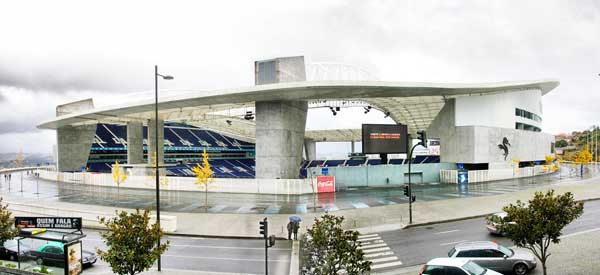
View of Estadio do Dragao
F.C. Porto Info
| Full Name: | Futebol Clube do Porto |
|---|---|
| Rivals: | SL Benfica (O Clássico), Sporting Clube de Portugal, Boavista (O Dérbi da Invicta) |
| Founded: | 1893 |
| Team Colours: | Blue and White |
| Club Mascot: | The Dragon |
| Nicknames: | Dragões (Dragons), Azuis e brancos (Blue and whites) |
| Training Ground: | CTFD PortoGaia |
| Former Stadiums: | Campo da Rainha (1906-1913), Campo da Constituição (1913-1952), Estádio das Antas (1952-2004) |
| Famous Players: | Deco, Radamel Falcao, Pepe, Ricardo Quaresma, Ricardo Carvalho, Hulk, James Rodríguez |
| Famous Managers: | Jose Mourinho, Bobby Robson, André Villas-Boas, Jesualdo Ferreira, Sérgio Conceição |
| Team Owner: | Jorge Nuno de Lima Pinto da Costa |
| Team Goalscorer: | Fernando Gomes (355) |
| Most Appearances: | João Pinto (587) |
| Official Website: | https://www.fcporto.pt/pt |
| Team Wikipedia: | https://en.wikipedia.org/wiki/FC_Porto |
Estadio do Dragao Seating Plan
Stand Photos
Matchday Experience
Estadio do Dragao Away Section
For domestic matches away fans are usually housed block 21 within the north-east corner of the ground within “Bancada Norte”. A relatively small section of seating this probably changes for big European matches.
Best Pubs near ground
The majority of drinking establishments are to be found back within the city centre rather than at the stadium.
Food - Places to eat
Across the road on the northern side of the ground there is a shopping centre known as Dolce Vita.
Porto Club Shop
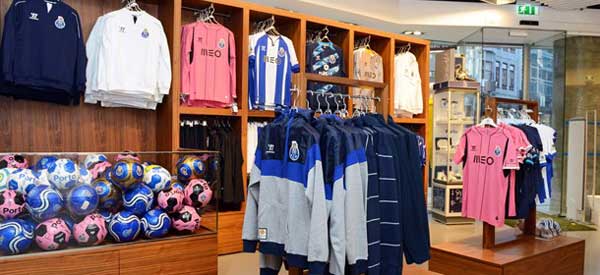
Porto Club Shop
FC Porto operate several shops throughout the city in addition to their very own online Loja (Shop). The main club store which is most widely visited by fans is at The Dragao stadium, located next to the museum.
Opening Times:
- Seven days a week: 10.00 am – 7.00 pm
- Matchdays: Usually open until kick-off
Can you take a stadium Tour?
Fully guided tours of the facilities at Estádio do Dragão last around 45 minutes and are usually conducted every 30 minutes until 4.00 pm. Starting inside the Porto Museum, the stadium tour has become one of the most popular tourist attractions in the city since opening.
Tour & Museum Price
- Adults: €15.00
- Seniors (Over 64): €12.00
- Children (Under 16): €10.00
Please note that you don’t have to visit both, and can book separately, however most tourists end up combining both for the full Porto experience.
How to buy Porto Tickets
Tickets to see Porto play at home can either be purchased online or from the ticket office at the stadium in the days leading up to the match.
Ticket Prices 2014/2015
- Arq. Meo and Moche: €15.00
- Central Meo and Moche: €30.00
- Lateral Meo and Moche: €20.00
- Superior Coca-Cola G: €12.00
- Superior Super Block
- Tribuna: €40.00
Please note that the above prices are based on a match against Gil Vicente FC who are one of the smaller teams in the league and thus tickets for other matches may well be slightly more expensive (€5.00- €20.00) for other home games.
How to get to Estadio do Dragao
Where is Estadio do Dragao?
Estadio do Dragao is located approximately 4.5km from Praça Mouzinho de Albuquerque which is said to be Porto’s city centre.
Driving
The address for satnav is as follows:
- Via Futebol Clube do Porto, 4350-415 Porto, Portugal
Car parks
There are a few private car parks within a 5-10 minute radius of the ground, however they usually fill up fast so make sure that you get there early.
Train - Public Transport
Porto is served by two railway stations known as Estação de São Bento in the city centre, and Porto-Campanhã station which sits east of the city. Both serve a mixture of commuter routes, direct services to Spanish cities such as Madrid.
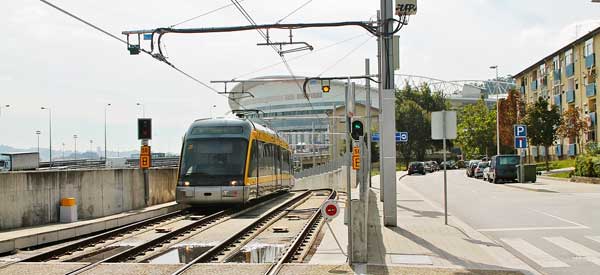
Public Transport of Estadio do Dragao
Metro
The stadium has its very own metro station known as Estadio do Dragao, and is is the last stop on lines A (Blue), B (Red) and E (Purple). It is also reachable from the orange line F which makes it highly accessible from almost anywhere in the city.
Airports and Flying
The closest airport Francisco Sa Carneiro is 15km north-west from the city centre. Sometimes referred to as just Aeroporto do Porto once you have landed you can catch Metro Line E to the city centre, and even the stadium itself for a few euros.
Hotels Near Estadio do Dragao
The closest hotel appears to be AC Hotel Porto which is 2 minutes north of the stadium next to the Dolce Vita shopping centre.
Frequently Asked Questions
Who plays at Estadio do Dragao?
Portuguese side Porto play their home matches at Estadio do Dragao.
What is the capacity of Estadio do Dragao?
As of 2024 Estadio do Dragao has an official seating capacity of 50,035 for Football matches.
When was Estadio do Dragao opened?
Estadio do Dragao officially opened in 2003 and is home to Porto
What is the postcode for Estadio do Dragao?
The postcode for Estadio do Dragao is 4350-415.
Are there any Covid restrictions at the stadium?
Covid Restrictions may be in place when you visit Estadio do Dragao in 2024. Please visit the official website of Porto for full information on changes due to the Coronavirus.



